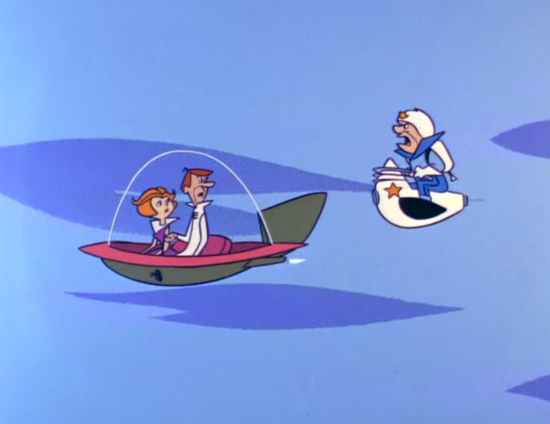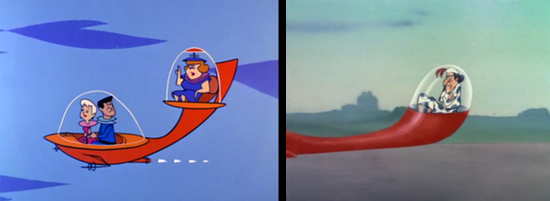Recapping ‘The Jetsons’: Episode 03 – The Space Car
The Jetsons didn’t invent the flying car, but it sure did a lot to cement the idea of the airborne automobile into the American imagination
![]()

Screenshot from the third episode of The Jetsons, The Space Car (originally aired October 7, 1962)
This is the third in a 24-part series looking at every episode of “The Jetsons” TV show from the original 1962-63 season.
Each and every year at least one company goes knocking on the doors of the major news outlets and announces to the world that the futuristic vision of a flying car will be a practical reality within a few short years. Some of these companies appear to be making these promises in earnest, fully recognizing that their flying cars — should they ever hit the market — will be wildly expensive and essentially just road-legal airplanes. Other flying car companies are far more sketchy and have gotten into hot water with the FEC over their questionable fundraising practices.
But any way you look at it, a flying car in every garage is still a long way from becoming a part of the average American’s reality.
The Jetsons didn’t invent the flying car, but it sure did a lot to cement the idea of the airborne automobile into the American imagination. The third episode of “The Jetsons” is the show’s first in-depth look at the cars of the future. Titled “The Space Car,” the episode originally aired on Sunday October 7, 1962.
The episode opens with a seemingly sentient computer doing its best to wake George from his slumber. The family all meets for breakfast in the dining room and George does his best to cook a meal by push-button. In true early-TV sitcom fashion George fails miserably at this task. Jane talks to her friend by videophone and then we’re introduced to two shady-looking characters who will serve to create confusion with their cops and robbers hijinks. George and Jane set out to buy a new car and arrive at Molecular Motors where they and the viewers at home are treated to a car salesman’s pitch from the year 2062.

The fold-up flying car of the future as imagined in the third episode of The Jetsons
Longtime readers of Paleofuture will, of course, be familiar with dozens of flying cars that predate the 1962 arrival of The Jetsons on the small screen. From the fully functional (if impractical) Aerocar of the early 1950s to Hugo Gernsback’s 1923 vision of a two-wheeled flying car, we’ve seen hundreds of predictions for the flying car of the future throughout the 20th century. Plenty of flying cars would follow the Jetsons as well, like when two men in California died in 1973 after they tried strapping airplane wings on a Pinto.
The car shopping montage in this episode appears to have been inspired by the tone and style of Tex Avery‘s late-1940 and early-’50s “Of Tomorrow” cartoons. Avery’s cartoons looked at the TV, house, farm and car of tomorrow with an irreverent flare. Many of the sight gags from “The Space Car” pay homage to this style of dissecting the various goofy caricatures of futuristic thinking, adhering to the comedic (and often sexist) stylings of the time.
In fact, the “mother-in-law” joke we see in The Jetsons is identical to that of Tex Avery’s “Car of Tomorrow” cartoon short, right down to the color of the car.

(Left) The Jetsons episode from Oct 7, 1962 (Right) The Tex Avery short cartoon “Car of Tomorrow” from 1951
The car companies themselves, as much as anyone, were promoting the idea of a radical shift in automobiles in the coming decades. The April 25, 1959 issue of the Chicago Daily Tribune relayed the beliefs of Ford VPs, who touted the flying car as one of the many innovations still to come:
Can you imagine an autoist driving up to a “gas” station 50 years from now and receiving replacement energy capsules for his car instead of getting a tank full of liquid fuel?
Also, can you imagine flying automobiles directed by automatic guidance systems?
These were possibilities discussed last week by Dr. Andrew A. Kucher, Ford Motor company vice president in charge of engineering and research, in an address at Northwestern University.
Arthur Radebaugh‘s syndicated Sunday comic “Closer Than We Think” was also a likely inspiration for The Jetsons’ vision of flying cars. The April 6, 1958 edition of the strip imagined cars that would ride on a cushion of air, according to Kucher, who was eager to tout this idea in the press during that time.

The “flying carpet car” from the April 6, 1958 edition of Arthur Radebaugh’s “Closer Than We Think”
Look, pa, no wheels! Use of a thin layer of compressed air may allow autos to hover and move just above ground level.
A pipe dream? Not at all. The concept (already proved) comes from scientist Andrew Kucher, vice-president of engineering at one of our major motor companies. His people are studying how to maintain stability. Special highway engineering is one way. Another is skillful design, evidenced already in experimental ideas from the staff of motor stylist George W. Walker.
Today’s earthbound cars won’t turn into low flying carpets right away. But it may happen sooner than we think!
The episode essentially boils down to the “men can’t cook, women can’t drive, mother-in-laws are terrible” sitcom trope, but the episode serves to further the vision of a technologically advanced society. Unfortunately for The Jetsons, it was on October 7, 1962 that they started to get their bad press. As I mentioned in my first post about the historical significance of The Jetsons, the show struggled as it was up against the tremendously popular “Walt Disney’s Wonderful World of Color.” Filling in for Jay Fredericks of the Gazette Mail in Charleston, West Virgina, writer L.T. Anderson wrote of his love for what Disney had been doing the past few Sundays on NBC, and his distaste for The Jetsons on ABC in that same time slot: “The Jetsons, a cartoon series about a family of the future, was so bad that my eight-year-old son turned off and said a dirty word.”

The car dealership of the future from the third episode of The Jetsons
/https://tf-cmsv2-smithsonianmag-media.s3.amazonaws.com/accounts/headshot/matt-novak-240.jpg)
/https://tf-cmsv2-smithsonianmag-media.s3.amazonaws.com/accounts/headshot/matt-novak-240.jpg)